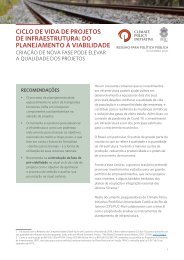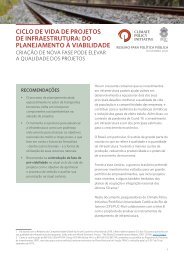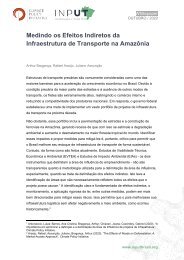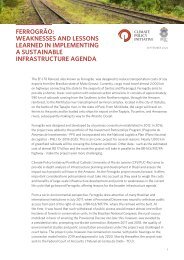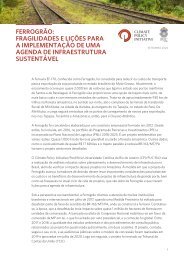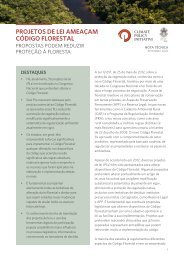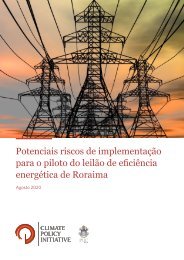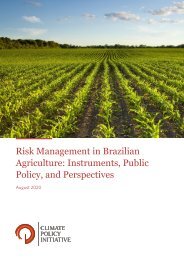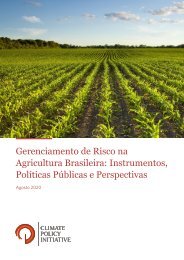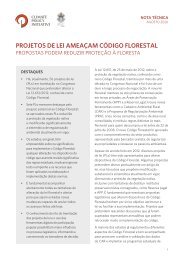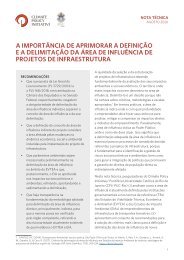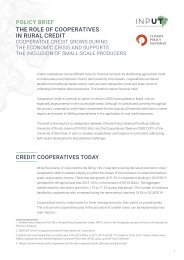The Need to Better Define and Delimit Area of Influence for Infrastructure Projects
Create successful ePaper yourself
Turn your PDF publications into a flip-book with our unique Google optimized e-Paper software.
VALEC’s manual, the delimitation <strong>of</strong> areas <strong>of</strong> direct <strong>and</strong> indirect influence must be justified <strong>to</strong><br />
show, unequivocally, the interactions between the railroad <strong>and</strong> the geographical area.<br />
<strong>The</strong>se agencies use the definition <strong>of</strong> areas <strong>of</strong> direct <strong>and</strong> indirect influence interchangeably<br />
with the concept <strong>of</strong> area delimitation. <strong>The</strong>y also believe that different criteria should be taken<br />
in<strong>to</strong> account in the delimitation process, which may cause some confusion, as these are two<br />
au<strong>to</strong>nomous agencies <strong>and</strong> yet both deal with l<strong>and</strong> transportation. <strong>The</strong> definitions also use<br />
certain terms as parameters that are only related with the economic feasibility <strong>of</strong> the project.<br />
However, the EVTEA also has an environmental component, allowing <strong>for</strong> the possible existence<br />
<strong>of</strong> environmental parameters when delimiting areas <strong>of</strong> influence.<br />
<strong>The</strong> National Environment Council (Conselho Nacional do Meio Ambiente - CONAMA), in turn,<br />
provides a general definition stating that the area <strong>of</strong> influence <strong>of</strong> a project is the “geographical<br />
area <strong>to</strong> be directly or indirectly affected by the impacts”. 4 In practice, the terms <strong>of</strong> reference (TRs)<br />
<strong>for</strong> preparing the EIA go further <strong>and</strong> state that the area <strong>of</strong> influence <strong>of</strong> a given project corresponds<br />
<strong>to</strong> the delimitation <strong>of</strong> the geographical area that will be directly affected by the project <strong>and</strong> <strong>to</strong> the<br />
areas under its indirect influence. In this case, it should be noted that the definition <strong>of</strong> the area <strong>of</strong><br />
influence uses the actual delimitation <strong>of</strong> the area.<br />
It is underst<strong>and</strong>able that the definition is linked <strong>to</strong> delimitation - after all, it is a geographical area<br />
that must be identified based on certain criteria so that the socio-economic <strong>and</strong> environmental<br />
impacts <strong>of</strong> a project can be mapped. However, separating the two concepts - “definition” <strong>and</strong><br />
“delimitation” - can make everything clearer - both when <strong>for</strong>mulating the terms <strong>of</strong> reference <strong>for</strong><br />
the EVTEA <strong>and</strong> the EIA, <strong>to</strong> indicate which criteria or methodology should guide the delimitation<br />
<strong>of</strong> the area <strong>of</strong> influence, <strong>and</strong> when determining who will design the studies.<br />
DELIMITATION OF AREAS OF INFLUENCE<br />
IN THE EVTEA AND EIA TERMS OF REFERENCE<br />
<strong>The</strong> area <strong>of</strong> influence is delimited in two moments within the life cycle <strong>of</strong> a project: in the<br />
EVTEA <strong>and</strong> the EIA - i.e., in the phase when l<strong>and</strong> transportation infrastructure projects undergo<br />
feasibility assessments.<br />
Due <strong>to</strong> the nature <strong>of</strong> these studies, it would make sense <strong>for</strong> the EVTEA <strong>to</strong> preliminarily delimit<br />
the area <strong>of</strong> influence <strong>and</strong> then the EIA would delve in<strong>to</strong> the socioeconomic <strong>and</strong> environmental<br />
impacts, thus consolidating the delimitation process. This is not necessarily what happens, not<br />
least because there is no legal obligation <strong>for</strong> the EVTEA <strong>to</strong> be carried out prior <strong>to</strong> the EIA.<br />
Despite the differences between the criteria employed by ANTT <strong>and</strong> VALEC, both consider areas<br />
<strong>of</strong> both direct <strong>and</strong> indirect influence in their respective definitions. In practice, however, the scope<br />
<strong>of</strong> EVTEA is limited <strong>to</strong> the area <strong>of</strong> direct influence <strong>of</strong> l<strong>and</strong> transportation projects. 5 It should also<br />
be noted that the studies do not justify the delimitation <strong>of</strong> the area <strong>of</strong> influence <strong>and</strong>, in the case<br />
<strong>of</strong> railroad projects, contain no indication as <strong>to</strong> whether the in<strong>for</strong>mation <strong>and</strong> data provided in the<br />
VALEC’s manual <strong>for</strong> EVTEA preparation manual were, in fact, heeded. 6<br />
4 CONAMA Resolution No. 01, <strong>of</strong> January 23, 1986.<br />
5 <strong>The</strong> EVTEA <strong>for</strong> the following projects were analyzed: Ferrogrão, Ferronorte (Cuiabá-Santarém), FICO (Por<strong>to</strong> Velho - Vilhena), Norte-Sul<br />
(Açailândia-Palmas), BR-364 (Rondonópolis / MT-Jataí / GO) <strong>and</strong> BR-163 (Sinop / MT-Miritituba / PA)<br />
6 Ibid.<br />
3




